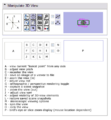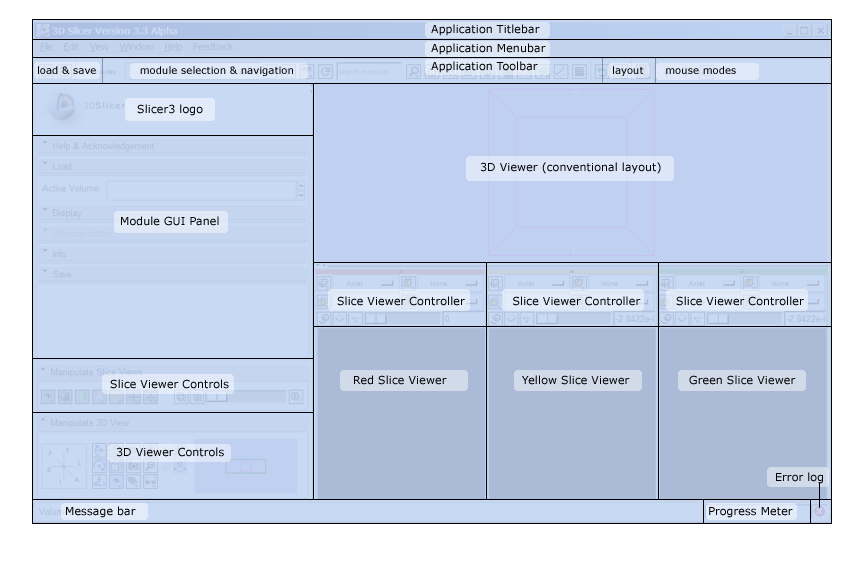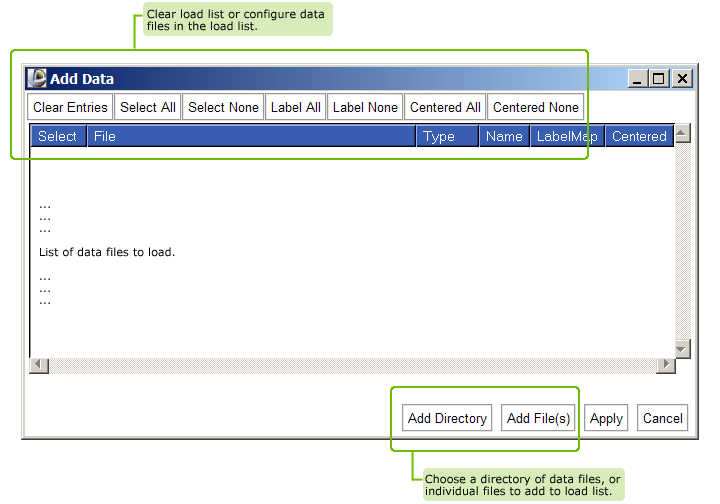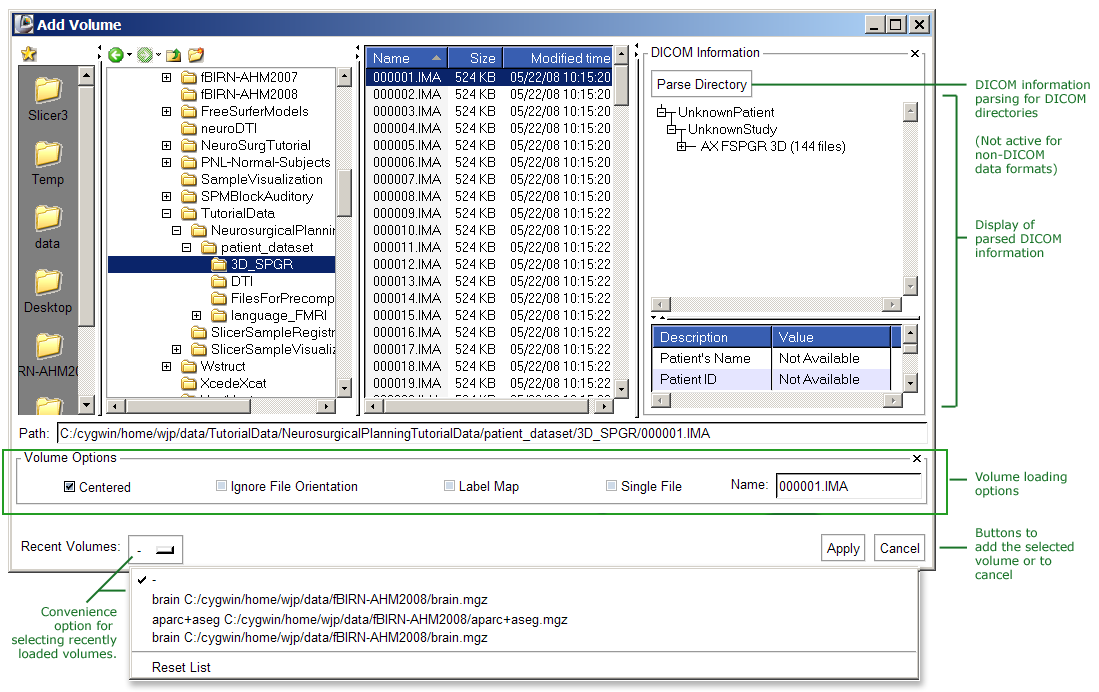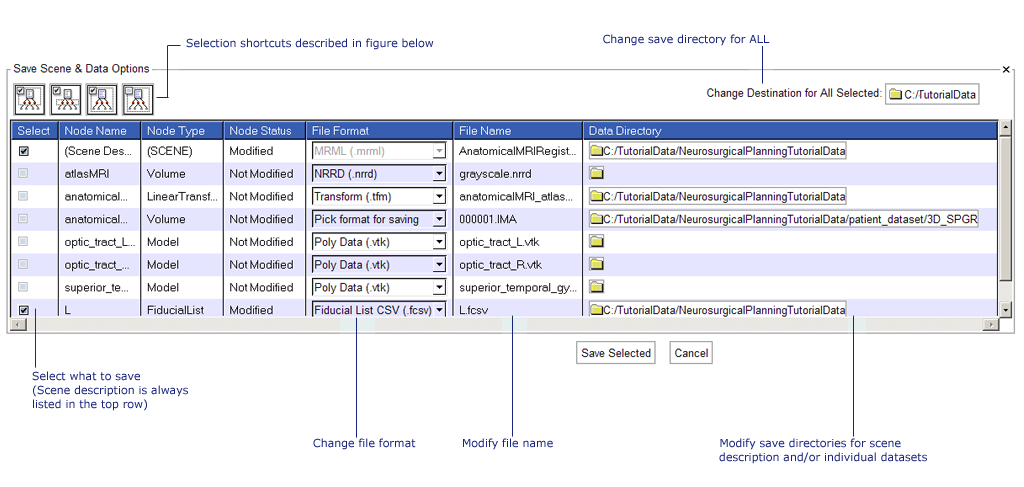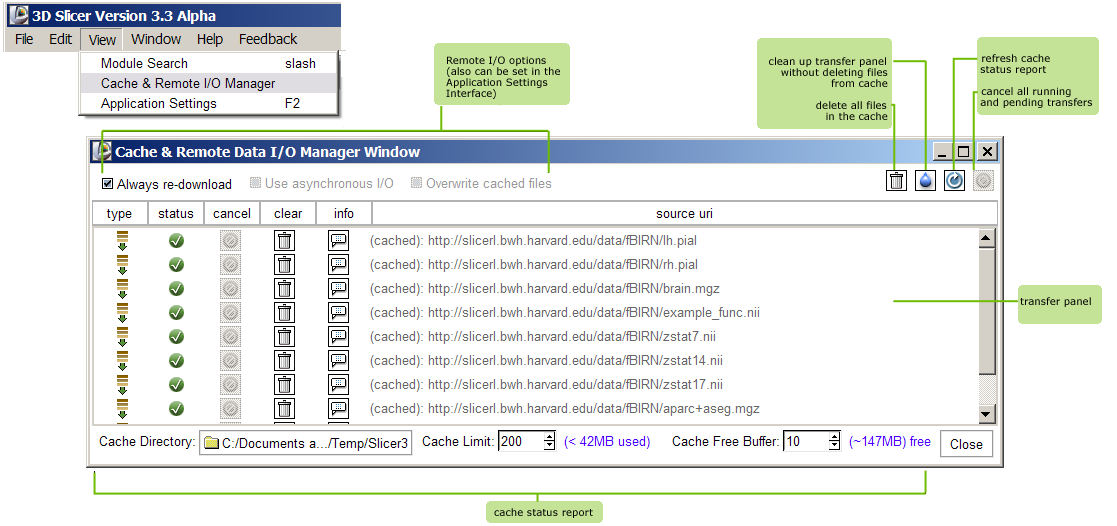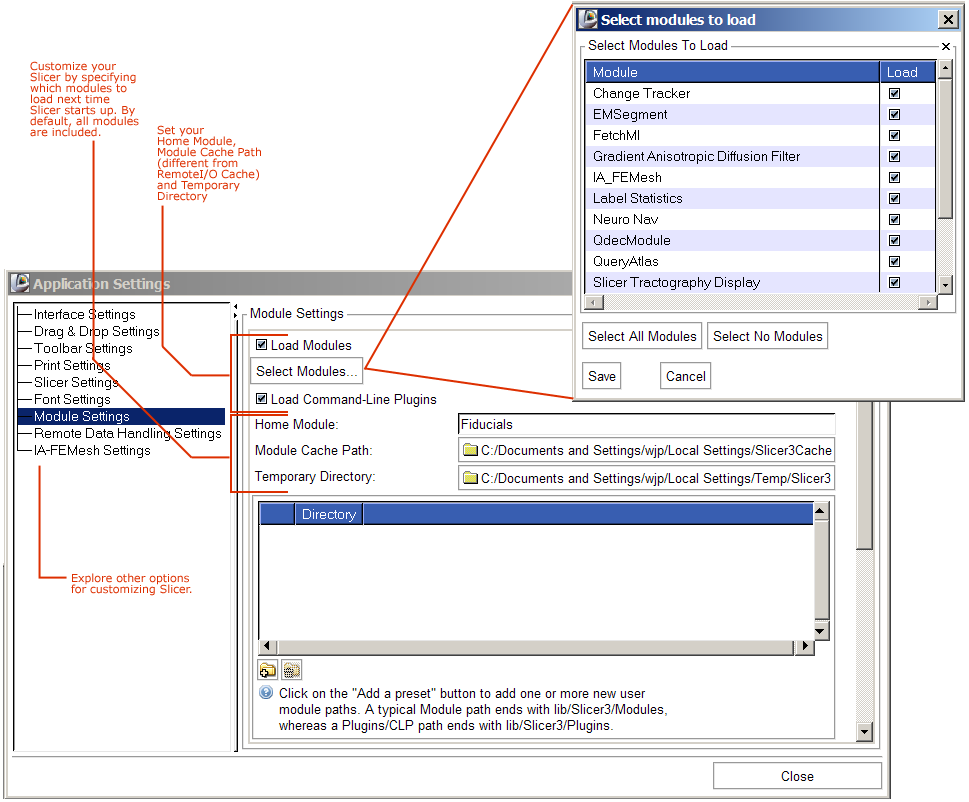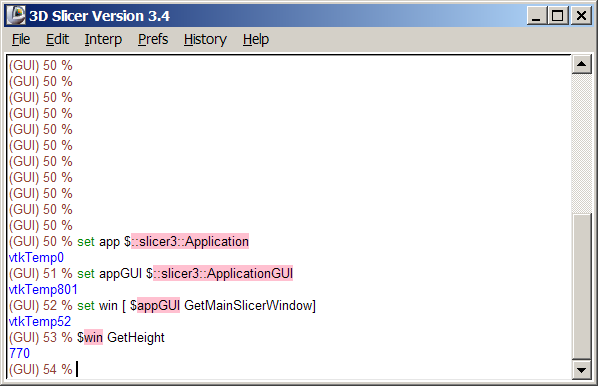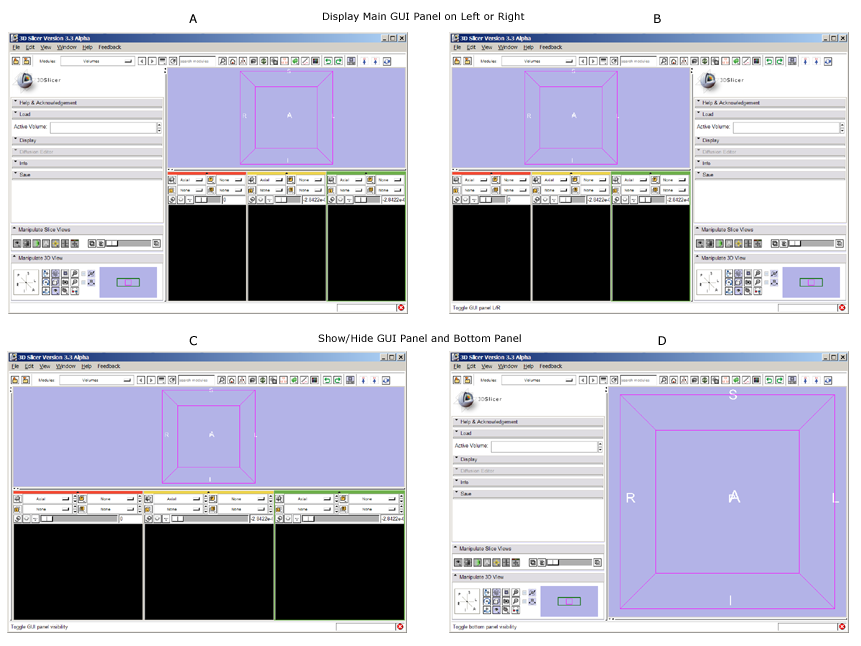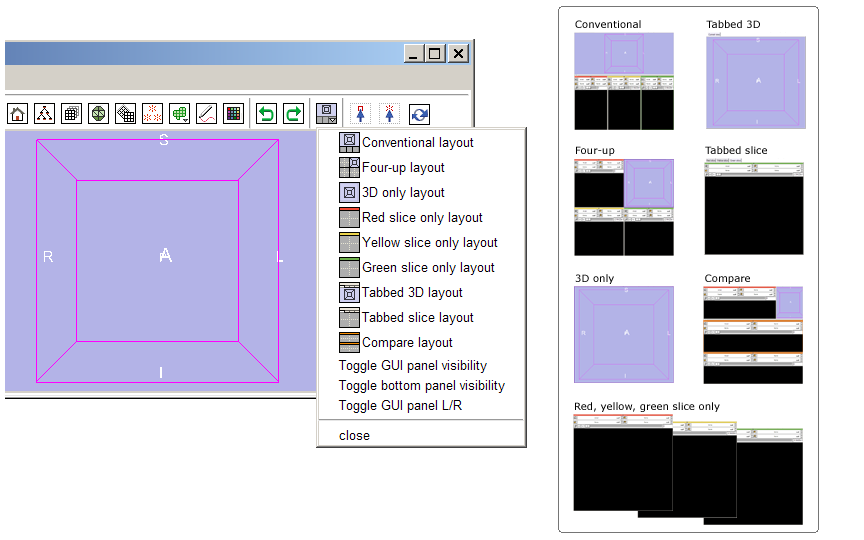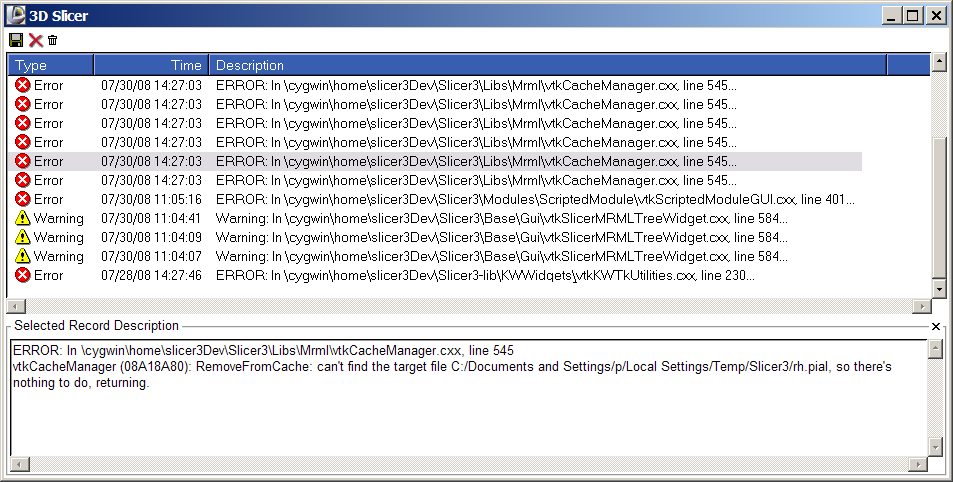Difference between revisions of "Modules:MainApplicationGUI-Documentation"
| Line 106: | Line 106: | ||
'''Edit->New Fiducial List''' This command creates a new list of fiducial points. | '''Edit->New Fiducial List''' This command creates a new list of fiducial points. | ||
| + | |||
| + | |||
===View menu === | ===View menu === | ||
Revision as of 15:29, 5 August 2008
Home < Modules:MainApplicationGUI-DocumentationReturn to Slicer Documentation
Contents
Main Application GUI organization
Slicer3's main desktop interface provides top-level access to most commonly-used features, and organizes them into logical groupings. These groups of features are presented in a number of interface panels on the GUI, as is illustrated in the basic layout below. The interface is designed to be easy to learn and remember, to ease navigation of Slicer's large (and growing) functionality, and to easily collapse and hide when you don't need to see it. Figures A through H in the gallery at the top of this page provide richer detail and will be described in sections below.
As shown above, the logical groupings of Slicer's interface elements include:
- The Application Menubar
- The Application Toolbar
- The Main GUI Panel, which consists of:
- Slicer's Logo Panel
- The Module GUI Panel
- The Slice Viewer Controls
- The 3D Viewer Controls
- The 3D Viewer
- Three Main Slice Viewers (Red, Yellow, and Green)and additional Slice Viewers
- The Message Bar and Progress Gauge
- And the Error Log Button
An overview of the functionality provided in each of these interface elements is provided below.
Application Menubar
The Application menubar is at the very top of Slicer3's main window, as noted above and in Figure A. Its menus and functionality are briefly listed below.
File->Load Scene: This command raises a file browser so that you can navigate to a MRML scene and select it for loading into Slicer. The command first clears any existing scene in Slicer and resets the application state.
File->Import Scene: This command raises a file browser to that you can navigate to a RML scene and select it to be added to the existing Slicer scene.
File->Add Data: This command raises an "Add Data" widget (shown below) that allows you to select individual datasets to add to the existing scene:
- The "Add Directory" button adds all files within the selected directory to the file list.
- The "Add File(s)" button adds all selected files to the file list.
- The array of buttons across the top allow you to select and deselect files in the file list, remove selected files from the list, or describe how files should be loaded.
- The "Apply" button loads all datasets in the list, and
- The "Cancel" button aborts the entire load.
File->Add Volume: This command raises an "Add Volume" widget (shown below) that allows you to select a volumetric dataset to add to the existing scene. The "Volume Options" panel can be used to clarify how a selected dataset should be loaded and displayed.
File->Save: This command displays the "Save Data" widget, which offers many options for saving a scene and/or individual datasets. The widget includes a "Save Scene" panel and a "Save Data" panel beneath it.
Specifying a scene file to save: The Scene File button raises a file browser from which a file can be selected or a new scene file can be specified. If a scene has already been loaded from a MRML file, then its filename is presented as the default choice. To save the scene into a new MRML file, first select the directory/folder and then provide a file name. The Save Scene checkbox just below must be selected in order to save the scene file; otherwise, only selected datasets will be saved.
Indicating new and unsaved datasets: When the panel is first displayed, all datasets which have been newly created or modified since the scene was saved are checked by default in the "Save Data" panel's Save column. Any datasets in the scene can be checked/unchecked for saving/not saving using the checkboxes provided in this column. The Save All and Save None buttons check or uncheck all listed datasets, respectively. Any dataset's filepath and filename may be edited to save the dataset in a location different from that specified. To save an individual model/volume, first select it for storing and THEN select the directory/folder.
Converting to other data formats: Any dataset can be converted to a different (supported) format by editing the filename extension. Click at the end of the filepath/name string and edit. (nrrd is for nrrd files).
Supported formats include:
List current supported data formats here.
Saving data: Selecting the Save button will launch the scene/data saving process, and Cancel will abort it.
File->Close Scene: This command closes the current scene and resets the application state.
File->Exit This command exits Slicer.
Edit->Set Home This command sets a user's 'home module', which is the module displayed by default each time the Slicer application is started. The home module is saved in the Application Registry.
Edit->Undo This command undoes the history of undoable commands, from last to first.
Edit->Redo This command re-does the history of commands most recently undone, from last to first.
Edit->Edit Box This command raises the Edit-box, a lightweight image editing tool.
Edit->New Fiducial List This command creates a new list of fiducial points.
View->Module Search:
View->Cache & RemoteIO Manager: The Cache and Remote Data Handling interface provides status and information about all remote data transfers, and allows some control over the local cache. Remote I/O and Cache preferences can also be set in the Application Settings Interface, described next. Whether you set preferences here or there, they are saved in the Application Registry so that your settings are preserved each time you start up the Slicer Application.
The pop-up interface is shown below. Checkbuttons at the top left provide choices about download and caching behavior, and the cache directory, cache size limit, and cache free space buffer can be set at the interface bottom. Icon buttons at the top right allow global operations on all data transfers (cache clearing and transfer cancellation) and display updates (transfer panel cleanup and cache report refreshing). Each data transfer is listed in the transfer panel along with some information about its type and status.
Below, all of the Cache & Remote Data I/O Manager icons are listed and described:
View->Application Settings Interface: The Application Settings interface provides options for saving many of Slicer's Interface and Remote Data Handling options to the Application Registry, so they are preserved across sessions. The first time you start the application, it is recommended that you browse these settings and select options that you prefer. Some of the options provided in the interface are listed below:
- Slicer Settings allow you to specify whether Slicer should confirm on delete, and set the location for other applications that Slicer may need to use (Firefox, Zip, etc.).
- Font Settings options allows you to choose among several fonts and relative font sizes to be displayed in the GUI.
- Module Settings options allow you to select a Temporary directory, a home module (that will be displayed each time Slicer starts up) and whether Slicer should include loadable and command-line modules on startup.
- Remote Data Handling Settings options allow the specification of Cache and Remote Data I/O settings which are also configurable from the Cache and Remote Data I/O Manager described above.
Window->Hide/Show Main Panel (Hotkey = F5): This command collapses or expands the GUI panel and allows Slicer's viewers to occupy the entire application window, as shown below in Application Layouts figure C.
Window->Hide/Show Bottom Panel (Hotkey = F6): This command collapses or expands the bottom split-panel in which Slice viewers are conventionally displayed, allowing the 3D view to occupy the vertical extent of the application window. The behavior of this command will vary, and may not be appropriate, depending on the selected layout (-- available layouts are described below.)
Window->Toolbars: This command allows hiding or exposing sub-toolbars in the application toolbars, including the Load/Save toolbar, the undo/redo toolbar, the layout configuration, and the mouse mode toolbar.
Window->Log Window (Hotkey = Ctrl+Alt+E): This command raises the error log display.
Window->Tcl Interactor (Hotkey = Ctrl+T): This command raises the Tcl interactor for scripted interaction with Slicer data:
Help->Browse Tutorials: This functionality is being developed.
Help->About Slicer3: Provides a description of the Slicer3 effort and its support.
Feedback->Report a Bug: This command opens your Firefox web browser to http://www.na-mic.org/Bug/my_view_page.php so that any bug you encounter can quickly and easily be reported. Be sure to select the appropriate category for the bug and estimate its severity. It's recommended that you provide as much information as you can so that the bug can be reproduced by the development team.
Feedback->Report a Usability Issue: This command opens your Firefox web browser to http://www.na-mic.org/Bug/my_view_page.php so that any usability issue you encounter can quickly be captured. Be sure to select the "usability" category for the issue and estimate its severity. We request that you describe the way in which the usability issue is impacting your work so that the usability and development team can address the issue appropriately. Suggestions and ideas are welcome!
Feedback->Make a Feature Request: This command opens your Firefox web browser to http://www.na-mic.org/Bug/my_view_page.php so that community feature requests can easily be collected. We request that you clearly mark your submission as a "feature request" in the description field of the form.
Feedback->Community: This command opens your Firefox web browser to http://www.slicer.org/slicerWiki/index.php/Slicer3:VisualBlog where you can post screenshots of interesting ways you are using the Slicer3 software package in your research and share them with the Slicer community.
Application Toolbar
Module GUI Panel
Slice Viewer Control Panel
3D Viewer Control Panel
- Scene Snapshots
- Scene snapshots are a good way to record a particular composition of a view. Among the things recorded are: Models turned on or off. Thresholds, window level, are the cross sections on or off, etc.
- Click on the camera icon to record a scenesnapshot.
- Use the pull down menu to select from a list of existing ones.
- Click on the arrow to restore the view.
Main 3D Viewer
Slice Viewers & Controllers
- Slice viewers can be used to specify oblique reformats using the 'Reformat' orientation (instead of axial, coronal, sagittal) and CTRL-Right-Button-Move (subject to change).
- On each viewer, there is a menu button in the upper left of the control pane that usually says "axial", "coronal", or "sagittal". There is a forth option that one can select from the button which is "reformat".


